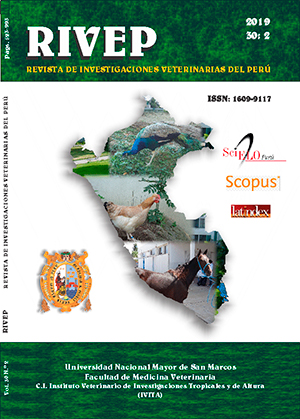Effect of dietary supplementation with mulberry (Morus alba) meal on the productive performance of growing quails (Coturnix coturnix japonica)
DOI:
https://doi.org/10.15381/rivep.v30i2.15088Keywords:
quails, diet, Morus alba, growth, cost-benefit ratioAbstract
The aim of this study was to evaluate the productive behavior of growing quail (Coturnix coturnix japonica) fed with a commercial balanced feed and supplemented with mulberry meal (Morus alba). The experiment was carried out in Trujillo, Venezuela, for six weeks. A completely randomized design was applied with three treatments (diets) and five repetitions per treatment (4 birds per repetition). The diets were: T0: 100% commercially balanced feed (AB); T1: 90% AB + 10% of mulberry meal (HM); T2: 80% AB + 20% HM. The final body weight (FW), daily weight gain (DWG), feed consumption (DI), specific growth rate (SGR), feed conversion (FC), carcass yield (CY), mortality and cost-benefit ratio were determined (CB). The data were processed by analysis of variance using the GLM procedure of the SAS program. The FW and the DWG were higher in T1 and T2 (PF: T0: 139.1 ± 1.9, T1: 147.2 ± 2.0, T2: 147.1 ± 1.9, (p<0.03) (DWG: T0: 3.1 ± 0.05, T1: 3.3 ± 0.05; T2: 3.3 ± 0.05 (p<0.03). The birds of T1 and T2 consumed more feed than those of T0 (p<0.01). The SGR was lower (p<0.05) in T0 (7.01%) than in T1 (7.13%) and T2 (7.14%). FC and CY did not vary between treatments. The CB ratio favored the birds of T1 and T2. It is concluded that the addition of HM in the ration improved FW, DWG and CB, constituting an alternative to reduce the feeding costs of the commercial establishments, without diminishing the productive indices of the birds.
Downloads
Downloads
Published
Issue
Section
License
Copyright (c) 2019 Fernando P Perea Ganchou

This work is licensed under a Creative Commons Attribution-NonCommercial-ShareAlike 4.0 International License.
AUTHORS RETAIN THEIR RIGHTS:
a. Authors retain their trade mark rights and patent, and also on any process or procedure described in the article.
b. Authors retain their right to share, copy, distribute, perform and publicly communicate their article (eg, to place their article in an institutional repository or publish it in a book), with an acknowledgment of its initial publication in the Revista de Investigaciones Veterinarias del Perú (RIVEP).
c. Authors retain theirs right to make a subsequent publication of their work, to use the article or any part thereof (eg a compilation of his papers, lecture notes, thesis, or a book), always indicating the source of publication (the originator of the work, journal, volume, number and date).



